A First Verification of Sim2DSphere Model’s Ability to Predict the Spatiotemporal Variability of Parameters Characterizing Land Surface Interactions at Diverse European Ecosystems
Abstract
1. Introduction
2. Experimental Set-Up
2.1. Sites Description
2.2. Datasets
2.2.1. FLUXNET Ground Monitoring Network
2.2.2. EO and Geospatial Data
2.2.3. Radiosondes Data
2.3. Sim2DSphere Model
3. Methodology
3.1. Pre-Processing
3.1.1. FLUXNET In-Situ
3.1.2. Radiosondes In-Situ
3.1.3. Geospatial Data
3.2. Sim2DSphere Parameterization
3.3. Statistical Comparisons
4. Results
4.1. Latent Heat Flux
4.2. Sensible Heat Flux
4.3. Net Radiation
5. Discussion
5.1. Diurnal Dynamics of Energy and Radiative Fluxes
Comparisons for Different Biomes
5.2. Potential Sources of Uncertainty and Limitations
5.3. Computational Requirements and Model Transferability
6. Final Remarks
Author Contributions
Funding
Institutional Review Board Statement
Informed Consent Statement
Data Availability Statement
Conflicts of Interest
References
- Calvin, K.; Dasgupta, D.; Krinner, G.; Mukherji, A.; Thorne, P.W.; Trisos, C.; Romero, J.; Aldunce, P.; Barrett, K.; Blanco, G.; et al. IPCC, 2023: Climate Change 2023: Synthesis Report. Contribution of Working Groups I, II and III to the Sixth Assessment Report of the Intergovernmental Panel on Climate Change; Core Writing Team, Lee, H., Romero, J., Eds.; Intergovernmental Panel on Climate Change (IPCC): Geneva, Switzerland, 2023. [Google Scholar]
- Intergovernmental Panel on Climate Change. Climate Change and Land: IPCC Special Report on Climate Change, Desertification, Land Degradation, Sustainable Land Management, Food Security, and Greenhouse Gas Fluxes in Terrestrial Ecosystems, 1st ed.; Cambridge University Press: Cambridge, UK, 2022; ISBN 978-1-00-915798-8. [Google Scholar]
- Gentine, P.; Green, J.K.; Guérin, M.; Humphrey, V.; Seneviratne, S.I.; Zhang, Y.; Zhou, S. Coupling between the Terrestrial Carbon and Water Cycles—A Review. Environ. Res. Lett. 2019, 14, 083003. [Google Scholar] [CrossRef]
- te Wierik, S.A.; Cammeraat, E.L.H.; Gupta, J.; Artzy-Randrup, Y.A. Reviewing the Impact of Land Use and Land-Use Change on Moisture Recycling and Precipitation Patterns. Water Resour. Res. 2021, 57, e2020WR029234. [Google Scholar] [CrossRef]
- Jiang, K.; Pan, Z.; Pan, F.; Teuling, A.J.; Han, G.; An, P.; Chen, X.; Wang, J.; Song, Y.; Cheng, L.; et al. Combined Influence of Soil Moisture and Atmospheric Humidity on Land Surface Temperature under Different Climatic Background. iScience 2023, 26, 106837. [Google Scholar] [CrossRef]
- Vilà-Guerau de Arellano, J.; Hartogensis, O.; Benedict, I.; de Boer, H.; Bosman, P.J.M.; Botía, S.; Cecchini, M.A.; Faassen, K.A.P.; González-Armas, R.; van Diepen, K.; et al. Advancing Understanding of Land–Atmosphere Interactions by Breaking Discipline and Scale Barriers. Ann. N. Y. Acad. Sci. 2023, 1522, 74–97. [Google Scholar] [CrossRef]
- Fiedler, S.; Naik, V.; O’Connor, F.M.; Smith, C.J.; Griffiths, P.; Kramer, R.J.; Takemura, T.; Allen, R.J.; Im, U.; Kasoar, M.; et al. Interactions between Atmospheric Composition and Climate Change–Progress in Understanding and Future Opportunities from AerChemMIP, PDRMIP, and RFMIP. Geosci. Model Dev. 2024, 17, 2387–2417. [Google Scholar] [CrossRef]
- European Commission. Report From the Commission to the European Parliament and The Council Eu Climate Action Progress Report 2023; European Commission: Brussels, Belgium, 2023. [Google Scholar]
- Snyder, R.L.; de Melo-Abreu, J.P. Frost Protection: Fundamentals, Practice and Economics; Environment and Natural Resources Series; Food and Agriculture Organization of the United Nations: Rome, Italy, 2005; ISBN 978-92-5-105328-7. [Google Scholar]
- Fisher, R.A.; Koven, C.D. Perspectives on the Future of Land Surface Models and the Challenges of Representing Complex Terrestrial Systems. J. Adv. Model. Earth Syst. 2020, 12, e2018MS001453. [Google Scholar] [CrossRef]
- Baldocchi, D.; Falge, E.; Gu, L.; Olson, R.; Hollinger, D.; Running, S.; Anthoni, P.; Bernhofer, C.; Davis, K.; Evans, R.; et al. FLUXNET: A New Tool to Study the Temporal and Spatial Variability of Ecosystem-Scale Carbon Dioxide, Water Vapor, and Energy Flux Densities. Bull. Am. Meteorol. Soc. 2001, 82, 2415–2434. [Google Scholar] [CrossRef]
- Wilson, K.; Goldstein, A.; Falge, E.; Aubinet, M.; Baldocchi, D.; Berbigier, P.; Bernhofer, C.; Ceulemans, R.; Dolman, H.; Field, C.; et al. Energy Balance Closure at FLUXNET Sites. Agric. For. Meteorol. 2002, 113, 223–243. [Google Scholar] [CrossRef]
- Helbig, M.; Gerken, T.; Beamesderfer, E.R.; Baldocchi, D.D.; Banerjee, T.; Biraud, S.C.; Brown, W.O.J.; Brunsell, N.A.; Burakowski, E.A.; Burns, S.P.; et al. Integrating Continuous Atmospheric Boundary Layer and Tower-Based Flux Measurements to Advance Understanding of Land-Atmosphere Interactions. Agric. For. Meteorol. 2021, 307, 108509. [Google Scholar] [CrossRef]
- He, X.; Li, Y.; Liu, S.; Xu, T.; Chen, F.; Li, Z.; Zhang, Z.; Liu, R.; Song, L.; Xu, Z.; et al. Improving Predictions of Land-Atmosphere Interactions Based on a Hybrid Data Assimilation and Machine Learning Method. Hydrol. Earth Syst. Sci. Discuss. 2022, 2022, 1583–1606. [Google Scholar]
- Wang, Y.; Li, R.; Liang, M.; Ma, J.; Yang, Y.; Zheng, H. Impact of Crop Types and Irrigation on Soil Moisture Downscaling in Water-Stressed Cropland Regions. Environ. Impact Assess. Rev. 2023, 100, 107073. [Google Scholar] [CrossRef]
- Butterworth, B.J.; Desai, A.R.; Townsend, P.A.; Petty, G.W.; Andresen, C.G.; Bertram, T.H.; Kruger, E.L.; Mineau, J.K.; Olson, E.R.; Paleri, S.; et al. Connecting Land–Atmosphere Interactions to Surface Heterogeneity in CHEESEHEAD19. Bull. Am. Meteorol. Soc. 2021, 102, E421–E445. [Google Scholar] [CrossRef]
- Seiler, C.; Melton, J.R.; Arora, V.K.; Sitch, S.; Friedlingstein, P.; Anthoni, P.; Goll, D.; Jain, A.K.; Joetzjer, E.; Lienert, S.; et al. Are Terrestrial Biosphere Models Fit for Simulating the Global Land Carbon Sink? J. Adv. Model. Earth Syst. 2022, 14, e2021MS002946. [Google Scholar] [CrossRef]
- Ruiz-Vásquez, M.; Sungmin, O.; Arduini, G.; Boussetta, S.; Brenning, A.; Bastos, A.; Koirala, S.; Balsamo, G.; Reichstein, M.; Orth, R. Impact of Updating Vegetation Information on Land Surface Model Performance. J. Geophys. Res. Atmos. 2023, 128, e2023JD039076. [Google Scholar] [CrossRef]
- Dare-Idowu, O.; Jarlan, L.; Le-Dantec, V.; Rivalland, V.; Ceschia, E.; Boone, A.; Brut, A. Hydrological Functioning of Maize Crops in Southwest France Using Eddy Covariance Measurements and a Land Surface Model. Water 2021, 13, 1481. [Google Scholar] [CrossRef]
- De Pue, J.; Barrios, J.M.; Liu, L.; Ciais, P.; Arboleda, A.; Hamdi, R.; Balzarolo, M.; Maignan, F.; Gellens-Meulenberghs, F. Local-Scale Evaluation of the Simulated Interactions between Energy, Water and Vegetation in ISBA, ORCHIDEE and a Diagnostic Model. Biogeosciences 2022, 19, 4361–4386. [Google Scholar] [CrossRef]
- Anagnostopoulos, V.; Petropoulos, G.P.; Ireland, G.; Carlson, T.N. A Modernized Version of a 1D Soil Vegetation Atmosphere Transfer Model for Improving Its Future Use in Land Surface Interactions Studies. Environ. Model. Softw. 2017, 90, 147–156. [Google Scholar] [CrossRef]
- Carlson, T.N.; Person, A.A.; Canich, T.J.; Petropoulos, G.P. Simsphere: A Downloadable Soil–Vegetation–Atmosphere–Transfer (SVAT) Model for Teaching and Research. Bull. Am. Meteorol. Soc. 2021, 102, E2198–E2206. [Google Scholar] [CrossRef]
- Carlson, T.N. Limitations and the Value of Land Surface Models and Their Role in Remote Sensing. Remote Sens. Lett. 2023, 14, 649–653. [Google Scholar] [CrossRef]
- Baracchini, T.; Chu, P.Y.; Šukys, J.; Lieberherr, G.; Wunderle, S.; Wüest, A.; Bouffard, D. Data Assimilation of In Situ and Satellite Remote Sensing Data to 3D Hydrodynamic Lake Models: A Case Study Using Delft3D-FLOW v4.03 and OpenDA v2.4. Geosci. Model Dev. 2020, 13, 1267–1284. [Google Scholar] [CrossRef]
- Petropoulos, G.P.; Anagnostopoulos, V.; Lekka, C.; Detsikas, S.E. Sim2DSphere: A Novel Modelling Tool for the Study of Land Surface Interactions. Environ. Model. Softw. 2024, 178, 106086. [Google Scholar] [CrossRef]
- Sun, H.; Zhou, B.; Liu, H. Spatial Evaluation of Soil Moisture (SM), Land Surface Temperature (LST), and LST-Derived SM Indexes Dynamics during SMAPVEX12. Sensors 2019, 19, 1247. [Google Scholar] [CrossRef] [PubMed]
- Huerta-Bátiz, H.E.; Constantino-Recillas, D.E.; Monsiváis-Huertero, A.; Hernández-Sánchez, J.C.; Judge, J.; Aparicio-García, R.S. Understanding Root-Zone Soil Moisture in Agricultural Regions of Central Mexico Using the Ensemble Kalman Filter, Satellite-Derived Information, and the THEXMEX-18 Dataset. Int. J. Digit. Earth 2022, 15, 52–78. [Google Scholar] [CrossRef]
- Inoue, Y.; Olioso, A. Estimating the Dynamics of Ecosystem CO2 Flux and Biomass Production in Agricultural Fields on the Basis of Synergy between Process Models and Remotely Sensed Signatures. J. Geophys. Res. Atmos. 2006, 111, D24S91. [Google Scholar] [CrossRef]
- Mallick, K.; Wandera, L.; Bhattarai, N.; Hostache, R.; Kleniewska, M.; Chormanski, J. A Critical Evaluation on the Role of Aerodynamic and Canopy–Surface Conductance Parameterization in SEB and SVAT Models for Simulating Evapotranspiration: A Case Study in the Upper Biebrza National Park Wetland in Poland. Water 2018, 10, 1753. [Google Scholar] [CrossRef]
- Schmidt-Walter, P.; Trotsiuk, V.; Meusburger, K.; Zacios, M.; Meesenburg, H. Advancing Simulations of Water Fluxes, Soil Moisture and Drought Stress by Using the LWF-Brook90 Hydrological Model in R. Agric. For. Meteorol. 2020, 291, 108023. [Google Scholar] [CrossRef]
- Meusburger, K.; Trotsiuk, V.; Schmidt-Walter, P.; Baltensweiler, A.; Brun, P.; Bernhard, F.; Gharun, M.; Habel, R.; Hagedorn, F.; Köchli, R.; et al. Soil-Plant Interactions Modulated Water Availability of Swiss Forests during the 2015 and 2018 Droughts. Glob. Change Biol. 2022, 28, 5928–5944. [Google Scholar] [CrossRef]
- Chou, H.-K.; Ochoa-Tocachi, B.F.; Moulds, S.; Buytaert, W. Parameterizing the JULES Land Surface Model for Different Land Covers in the Tropical Andes. Hydrol. Sci. J. 2022, 67, 1516–1526. [Google Scholar] [CrossRef]
- Carlson, T.N.; Petropoulos, G.P. A New Method for Estimating of Evapotranspiration and Surface Soil Moisture from Optical and Thermal Infrared Measurements: The Simplified Triangle. Int. J. Remote Sens. 2019, 40, 7716–7729. [Google Scholar] [CrossRef]
- Mauder, M.; Foken, T.; Cuxart, J. Surface-Energy-Balance Closure over Land: A Review. Bound.-Layer Meteorol. 2020, 177, 395–426. [Google Scholar] [CrossRef]
- Pastorello, G.; Trotta, C.; Canfora, E.; Chu, H.; Christianson, D.; Cheah, Y.-W.; Poindexter, C.; Chen, J.; Elbashandy, A.; Humphrey, M.; et al. The FLUXNET2015 Dataset and the ONEFlux Processing Pipeline for Eddy Covariance Data. Sci. Data 2020, 7, 225. [Google Scholar] [CrossRef]
- Heiskanen, J.; Brümmer, C.; Buchmann, N.; Calfapietra, C.; Chen, H.; Gielen, B.; Gkritzalis, T.; Hammer, S.; Hartman, S.; Herbst, M.; et al. The Integrated Carbon Observation System in Europe. Bull. Am. Meteorol. Soc. 2022, 103, E855–E872. [Google Scholar] [CrossRef]
- Carlson, T.N.; Lynn, B. The Effects of Plant Water Storage on Transpiration and Radiometric Surface Temperature. Agric. For. Meteorol. 1991, 57, 171–186. [Google Scholar] [CrossRef]
- Lynn, B.H.; Carlson, T.N. A Stomatal Resistance Model Illustrating Plant vs. External Control of Transpiration. Agric. For. Meteorol. 1990, 52, 5–43. [Google Scholar] [CrossRef]
- Carlson, T.N.; Boland, F.E. Analysis of Urban-Rural Canopy Using a Surface Heat Flux/Temperature Model. J. Appl. Meteorol. 1978, 17, 998–1013. [Google Scholar] [CrossRef]
- Olioso, A.; Carlson, T.N.; Brisson, N. Simulation of diurnal transpiration and photosynthesis of a water stressed soybean crop. Agric. For. Meteor. 1996, 81, 41–59. [Google Scholar] [CrossRef]
- Petropoulos, G.; Carlson, T.N.; Wooster, M.J. An Overview of the Use of the SimSphere Soil Vegetation Atmosphere Transfer (SVAT) Model for the Study of Land-Atmosphere Interactions. Sensors 2009, 9, 4286–4308. [Google Scholar] [CrossRef]
- Petropoulos, G.P.; Srivastava, P.K.; Piles, M.; Pearson, S. Earth Observation-Based Operational Estimation of Soil Moisture and Evapotranspiration for Agricultural Crops in Support of Sustainable Water Management. Sustainability 2018, 10, 181. [Google Scholar] [CrossRef]
- Petropoulos, G.P.; Ireland, G.; Griffiths, H.M.; Kennedy, M.C.; Ioannou-Katidis, P.; Kalivas, D.P. Extending the Global Sensitivity Analysis of the SimSphere Model in the Context of Its Future Exploitation by the Scientific Community. Water 2015, 7, 2101–2141. [Google Scholar] [CrossRef]
- Petropoulos, G.P.; North, M.R.; Ireland, G.; Srivastava, P.K.; Rendall, D.V. Quantifying the Prediction Accuracy of a 1-D SVAT Model at a Range of Ecosystems in the USA and Australia: Evidence towards Its Use as a Tool to Study Earth’s System Interactions. Geosci. Model Dev. 2015, 8, 3257–3284. [Google Scholar] [CrossRef]
- Petropoulos, G.P. Extending Our Understanding on the Retrievals of Surface Energy Fluxes and Surface Soil Moisture from the “Triangle” Technique. Environ. Model. Softw. 2024, 181, 106180. [Google Scholar] [CrossRef]
- Carlson, T.N.; Ripley, D.A. On the Relation between NDVI, Fractional Vegetation Cover, and Leaf Area Index. Remote Sens. Environ. 1997, 62, 241–252. [Google Scholar] [CrossRef]
- Xavier, A.C.; Vettorazzi, C.A. Monitoring Leaf Area Index at Watershed Level through NDVI from Landsat-7/ETM+ Data. Sci. Agric. 2004, 61, 243–252. [Google Scholar] [CrossRef]
- Andalibi, L.; Ghorbani, A.; Moameri, M.; Hazbavi, Z.; Nothdurft, A.; Jafari, R.; Dadjou, F. Leaf Area Index Variations in Ecoregions of Ardabil Province, Iran. Remote Sens. 2021, 13, 2879. [Google Scholar] [CrossRef]
- Petropoulos, G.P.; Griffiths, H.M.; Carlson, T.N.; Ioannou-Katidis, P.; Holt, T. SimSphere Model Sensitivity Analysis towards Establishing Its Use for Deriving Key Parameters Characterising Land Surface Interactions. Geosci. Model Dev. 2014, 7, 1873–1887. [Google Scholar] [CrossRef]
- Petropoulos, G.P.; Lekka, C. Recent Developments to the SimSphere Land Surface Modelling Tool for the Study of Land–Atmosphere Interactions. Sensors 2024, 24, 3024. [Google Scholar] [CrossRef]
- Ireland, G.; Petropoulos, G.; Carlson, T.; Purdy, S. Addressing the ability of a land biosphere model to predict key biophysical vegetation characterisation parameters with Global Sensitivity Analysis. Environ. Model. Softw. 2015, 65, 94–107. [Google Scholar] [CrossRef]
- Cosby, B.J.; Hornberger, G.M.; Clapp, R.B.; Ginn, T.R. A Statistical Exploration of the Relationships of Soil Moisture Characteristics to the Physical Properties of Soils. Water Resour. Res. 1984, 20, 682–690. [Google Scholar] [CrossRef]
- Wißkirchen, K.; Tum, M.; Günther, K.P.; Niklaus, M.; Eisfelder, C.; Knorr, W. Quantifying the Carbon Uptake by Vegetation for Europe on a 1 Km2 Resolution Using a Remote Sensing Driven Vegetation Model. Geosci. Model Dev. 2013, 6, 1623–1640. [Google Scholar] [CrossRef]
- Xiang, T.; Vivoni, E.R.; Gochis, D.J.; Mascaro, G. On the Diurnal Cycle of Surface Energy Fluxes in the North American Monsoon Region Using the WRF-Hydro Modeling System. J. Geophys. Res. Atmos. 2017, 122, 9024–9049. [Google Scholar] [CrossRef]
- Bigeard, G.; Coudert, B.; Chirouze, J.; Er-Raki, S.; Boulet, G.; Ceschia, E.; Jarlan, L. Ability of a Soil–Vegetation–Atmosphere Transfer Model and a Two-Source Energy Balance Model to Predict Evapotranspiration for Several Crops and Climate Conditions. Hydrol. Earth Syst. Sci. 2019, 23, 5033–5058. [Google Scholar] [CrossRef]
- Prikaziuk, E.; Migliavacca, M.; Su, Z.B.; van der Tol, C. Simulation of Ecosystem Fluxes with the SCOPE Model: Sensitivity to Parametrization and Evaluation with Flux Tower Observations. Remote Sens. Environ. 2023, 284, 113324. [Google Scholar] [CrossRef]
- Huang, Y.; Guo, H.; Chen, X.; Chen, Z.; van der Tol, C.; Zhou, Y.; Tang, J. Meteorological Controls on Evapotranspiration over a Coastal Salt Marsh Ecosystem under Tidal Influence. Agric. For. Meteorol. 2019, 279, 107755. [Google Scholar] [CrossRef]
- Feldman, A.F.; Short Gianotti, D.J.; Trigo, I.F.; Salvucci, G.D.; Entekhabi, D. Satellite-Based Assessment of Land Surface Energy Partitioning–Soil Moisture Relationships and Effects of Confounding Variables. Water Resour. Res. 2019, 55, 10657–10677. [Google Scholar] [CrossRef]
- Wang, S.; Li, R.; Wu, Y.; Wang, W. Estimation of Surface Soil Moisture by Combining a Structural Equation Model and an Artificial Neural Network (SEM-ANN). Sci. Total Environ. 2023, 876, 162558. [Google Scholar] [CrossRef] [PubMed]
- Seyednasrollah, B.; Kumar, M.; Link, T.E. On the Role of Vegetation Density on Net Snow Cover Radiation at the Forest Floor. J. Geophys. Res. Atmos. 2013, 118, 8359–8374. [Google Scholar] [CrossRef]
- Gutiérrez-Jurado, H.A.; Vivoni, E.R. Ecogeomorphic Expressions of an Aspect-controlled Semiarid Basin: II. Topographic and Vegetation Controls on Solar Irradiance. Ecohydrology 2013, 6, 24–37. [Google Scholar] [CrossRef]
- Schirmbeck, J.; Fontana, D.C.; Roberti, D.R. Evaluation of OSEB and SEBAL Models for Energy Balance of a Crop Area in a Humid Subtropical Climate. Bragantia 2018, 77, 609–621. [Google Scholar] [CrossRef]
- van Heerwaarden, C.C.; Teuling, A.J. Disentangling the Response of Forest and Grassland Energy Exchange to Heatwaves under Idealized Land–Atmosphere Coupling. Biogeosciences 2014, 11, 6159–6171. [Google Scholar] [CrossRef]
- Guo, Y.; Cheng, J. Feasibility of Estimating Cloudy-Sky Surface Longwave Net Radiation Using Satellite-Derived Surface Shortwave Net Radiation. Remote Sens. 2018, 10, 596. [Google Scholar] [CrossRef]
- Zhang, Y.; Rossow, W.B.; Lacis, A.A.; Oinas, V.; Mishchenko, M.I. Calculation of Radiative Fluxes from the Surface to Top of Atmosphere Based on ISCCP and Other Global Data Sets: Refinements of the Radiative Transfer Model and the Input Data. J. Geophys. Res. Atmos. 2004, 109, D19105. [Google Scholar] [CrossRef]
- Marshall, M.; Tu, K.; Funk, C.; Michaelsen, J.; Williams, P.; Williams, C.; Ardö, J.; Boucher, M.; Cappelaere, B.; de Grandcourt, A.; et al. Improving Operational Land Surface Model Canopy Evapotranspiration in Africa Using a Direct Remote Sensing Approach. Hydrol. Earth Syst. Sci. 2013, 17, 1079–1091. [Google Scholar] [CrossRef]
- Liu, X.; He, B.; Guo, L.; Huang, L.; Chen, D. Similarities and Differences in the Mechanisms Causing the European Summer Heatwaves in 2003, 2010, and 2018. Earths Future 2020, 8, e2019EF001386. [Google Scholar] [CrossRef]
- McCabe, M.F.; Ershadi, A.; Jimenez, C.; Miralles, D.G.; Michel, D.; Wood, E.F. The GEWEX LandFlux Project: Evaluation of Model Evaporation Using Tower-Based and Globally Gridded Forcing Data. Geosci. Model Dev. 2016, 9, 283–305. [Google Scholar] [CrossRef]
- North, M.R.; Petropoulos, G.P.; Ireland, G.; McCalmont, J.P. Appraising the Capability of a Land Biosphere Model as a Tool in Modelling Land Surface Interactions: Results from Its Validation at Selected European Ecosystems. Earth Syst. Dyn. Discuss. 2015, 6, 217–265. [Google Scholar] [CrossRef]
- Ershadi, A.; McCabe, M.F.; Evans, J.P.; Chaney, N.W.; Wood, E.F. Multi-Site Evaluation of Terrestrial Evaporation Models Using FLUXNET Data. Agric. For. Meteorol. 2014, 187, 46–61. [Google Scholar] [CrossRef]
- Groenendijk, M.; Dolman, A.J.; van der Molen, M.K.; Leuning, R.; Arneth, A.; Delpierre, N.; Gash, J.H.C.; Lindroth, A.; Richardson, A.D.; Verbeeck, H.; et al. Assessing Parameter Variability in a Photosynthesis Model within and between Plant Functional Types Using Global Fluxnet Eddy Covariance Data. Agric. For. Meteorol. 2011, 151, 22–38. [Google Scholar] [CrossRef]
- Nassar, A.; Torres-Rua, A.; Kustas, W.; Alfieri, J.; Hipps, L.; Prueger, J.; Nieto, H.; Alsina, M.M.; White, W.; McKee, L.; et al. Assessing Daily Evapotranspiration Methodologies from One-Time-of-Day sUAS and EC Information in the GRAPEX Project. Remote Sens. 2021, 13, 2887. [Google Scholar] [CrossRef]
- Claverie, M.; Demarez, V.; Duchemin, B.; Hagolle, O.; Ducrot, D.; Marais-Sicre, C.; Dejoux, J.-F.; Huc, M.; Keravec, P.; Béziat, P.; et al. Maize and Sunflower Biomass Estimation in Southwest France Using High Spatial and Temporal Resolution Remote Sensing Data. Remote Sens. Environ. 2012, 124, 844–857. [Google Scholar] [CrossRef]
- Papale, D.; Reichstein, M.; Aubinet, M.; Canfora, E.; Bernhofer, C.; Kutsch, W.; Longdoz, B.; Rambal, S.; Valentini, R.; Vesala, T.; et al. Towards a Standardized Processing of Net Ecosystem Exchange Measured with Eddy Covariance Technique: Algorithms and Uncertainty Estimation. Biogeosciences 2006, 3, 571–583. [Google Scholar] [CrossRef]
- Lagouarde, J.-P.; Irvine, M.; Dupont, S. Atmospheric Turbulence Induced Errors on Measurements of Surface Temperature from space. Remote Sens. Environ. 2015, 168, 40–53. [Google Scholar] [CrossRef]
- Kramer, K.; Leinonen, I.; Bartelink, H.H.; Berbigier, P.; Borghetti, M.; Bernhofer, C.; Cienciala, E.; Dolman, A.J.; Froer, O.; Gracia, C.A.; et al. Evaluation of Six Process-Based Forest Growth Models Using Eddy-Covariance Measurements of CO2 and H2O Fluxes at Six Forest Sites in Europe. Glob. Change Biol. 2002, 8, 213–230. [Google Scholar] [CrossRef]
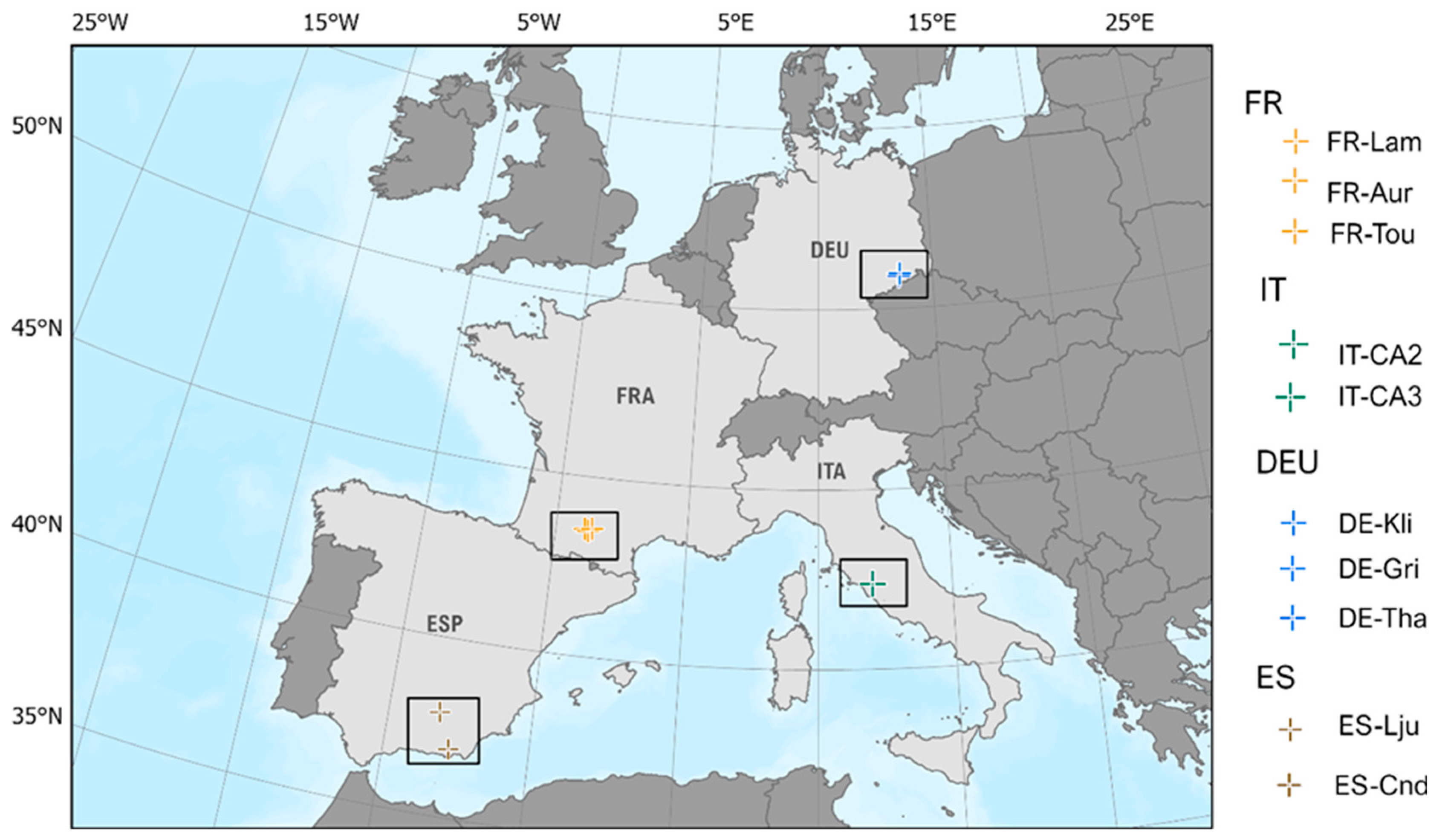
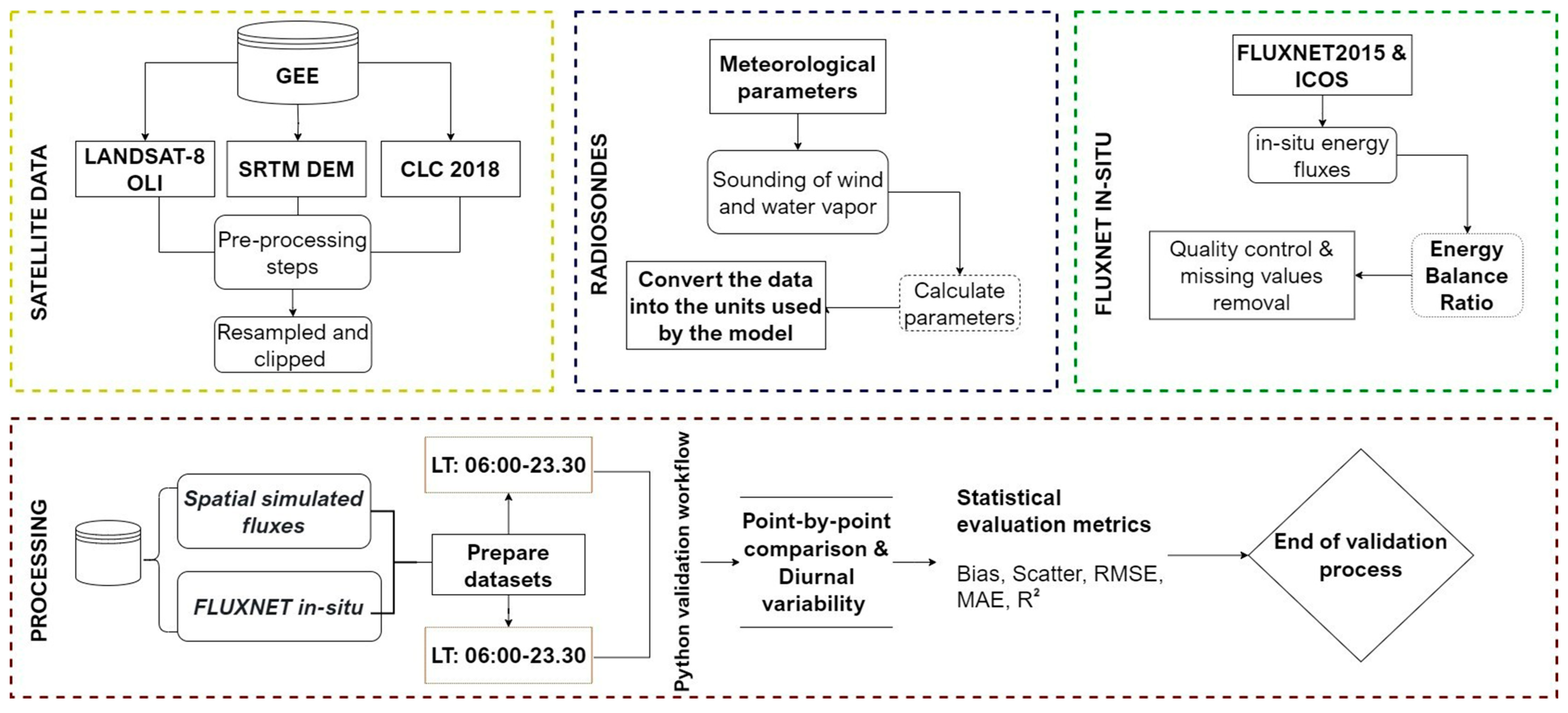
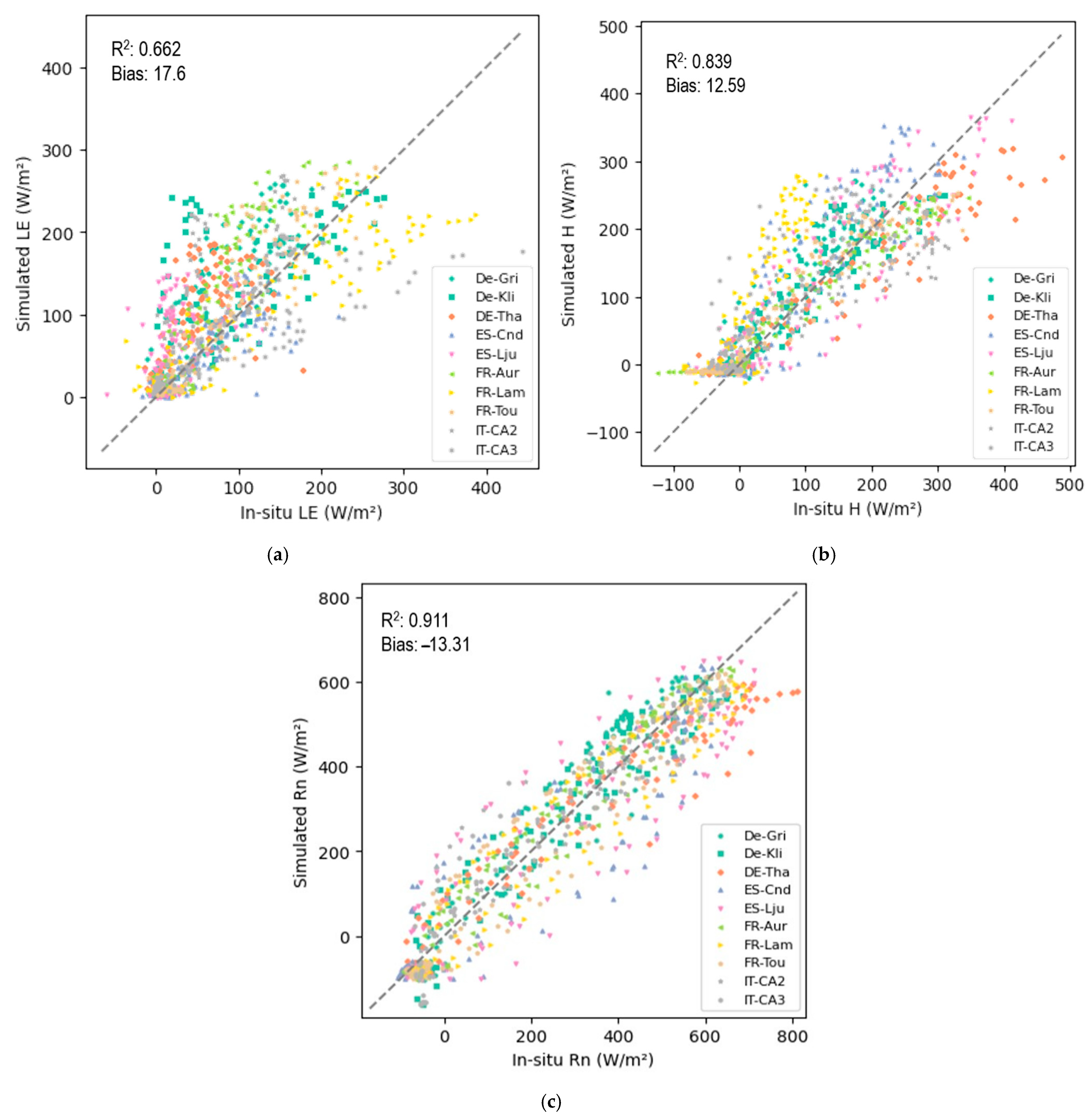

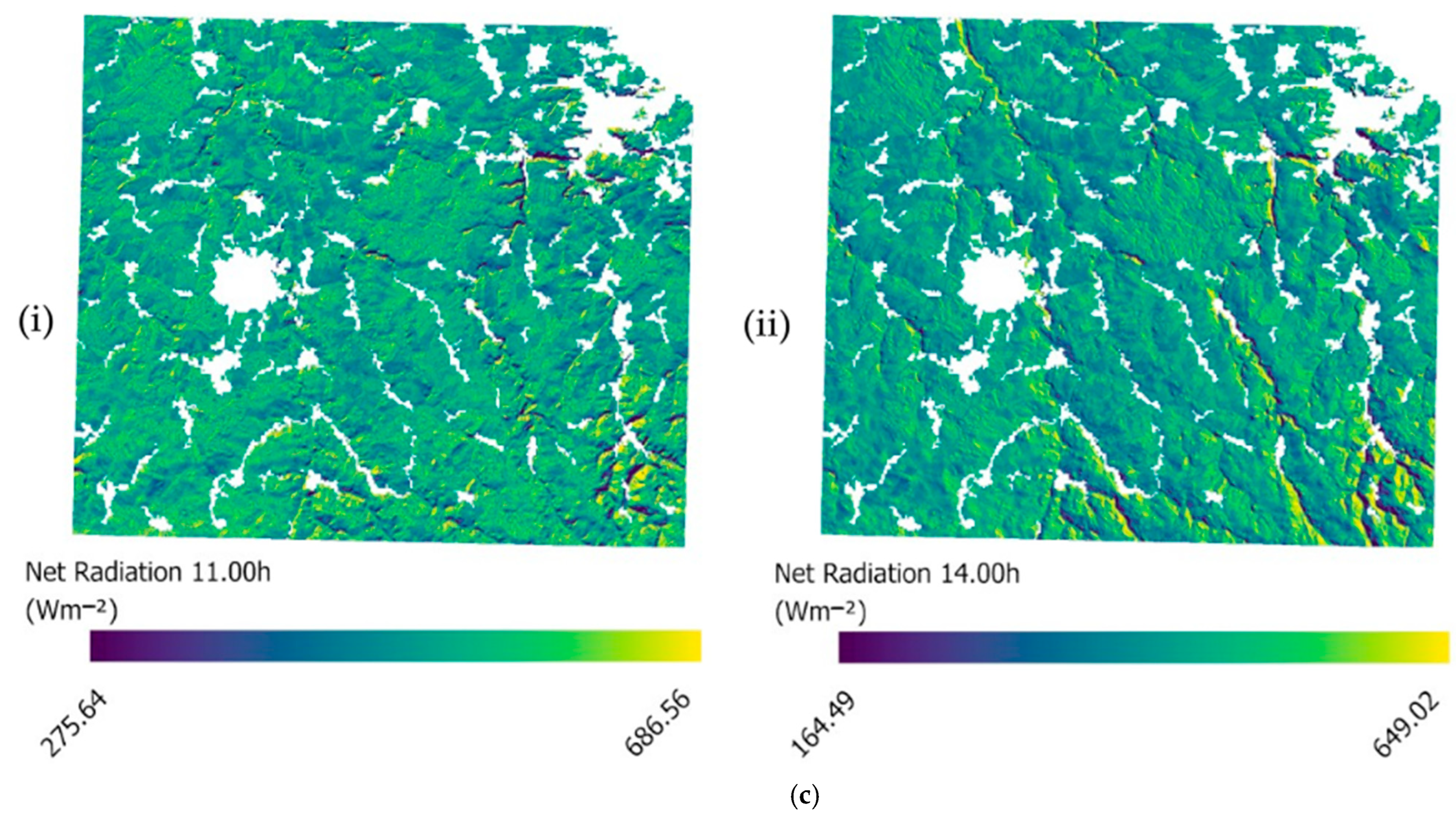
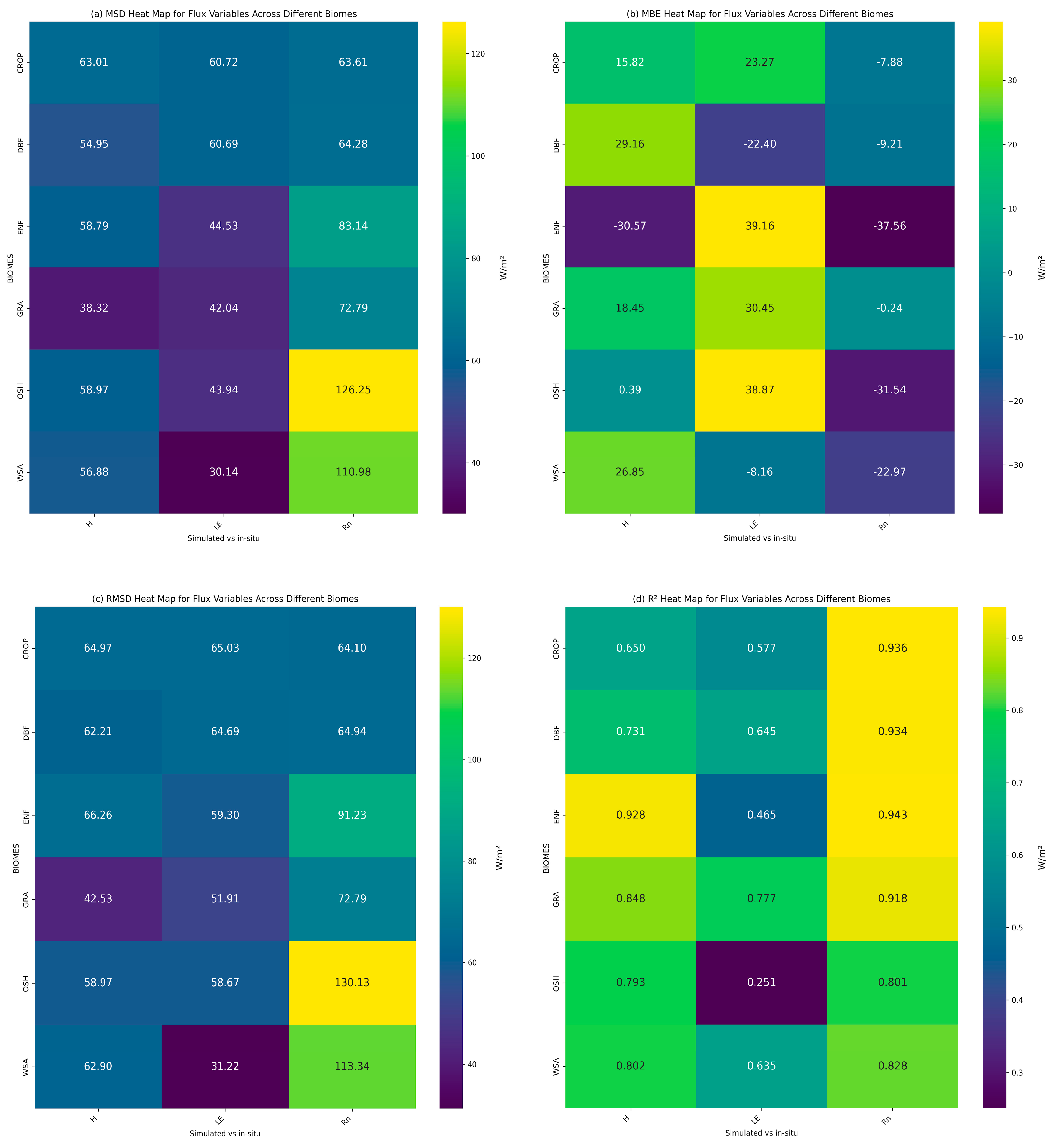
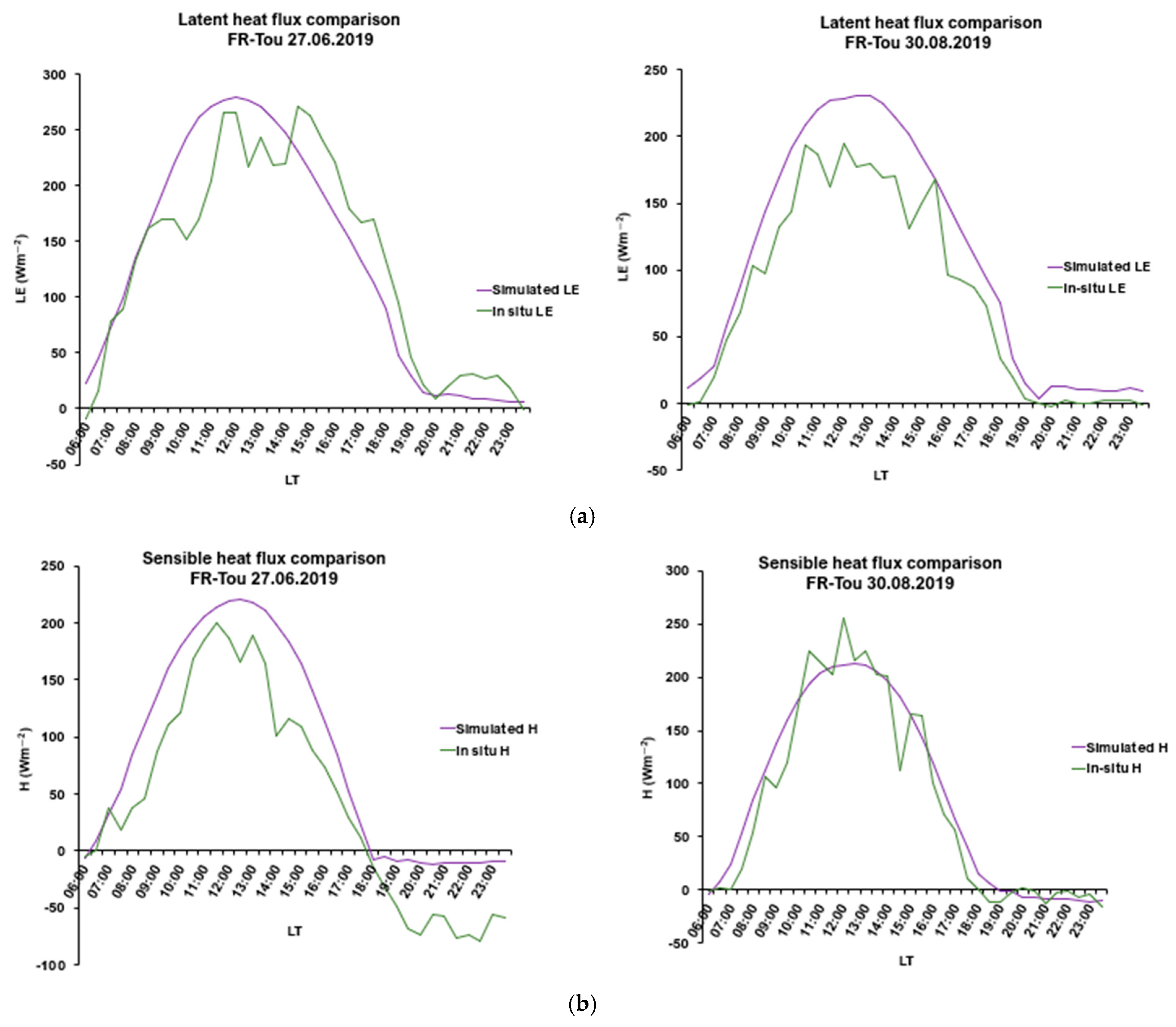
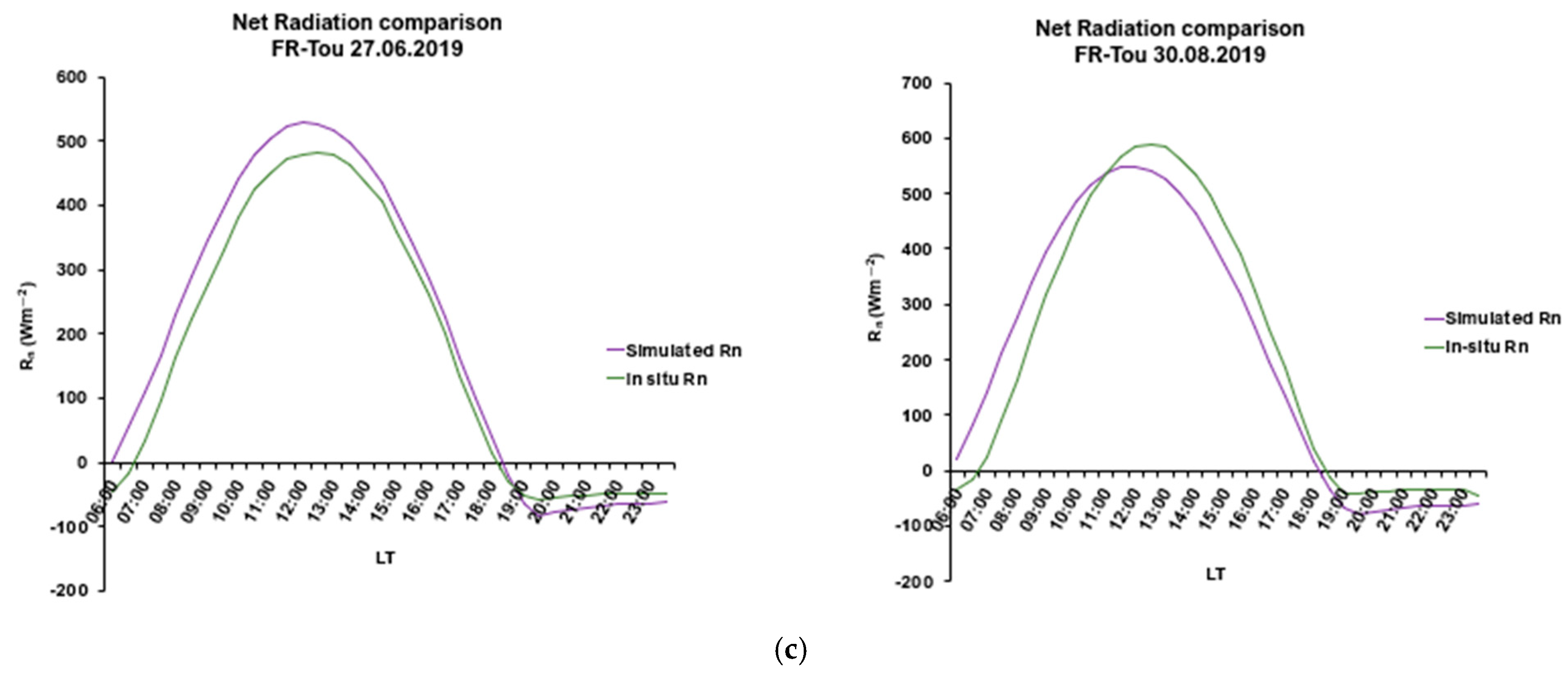
| Dates | Site | Lat/Lon | Height (~ in m) | Slope | Biome | Plant Type | Soil Type | Köppen |
|---|---|---|---|---|---|---|---|---|
| 11 June 2020 29 July 2020 14 August 2020 | ES-LJU | 36.926/2.752 | 2.5 | Gentle (<2%) | OSH | evergreen shrubs (macchia) | Clay loam | Csa |
| ES-CND | 37.915/−3.227 | 15 | Medium (>2%, <5%) | WSA | Olive cultivars | Clay loam | Csa | |
| 27 June 2019 29 July 2019 30 August 2019 | FR-AUR | 43.549/1.106 | 3.5 | Significant (>5%, <10%) | CROP | wheat | Clay loam | Cfb |
| FR-LAM | 43.493/1.237 | 3.6 | Flat | CROP | maize | Clay loam | Cfb | |
| FR-TOU | 43.572/1.374 | 3 | Flat | GRA | Grass | Clay-loam | Cfb | |
| 30 June 2018 10 August 2018 18 September 2018 | DE-KLI | 50.892/13.522 | 2 | Flat | CROP | maize | Loam | Cfb |
| DE-GRI | 50.950/13.513 | 3 | Flat | GRA | C3 short grass | Loam | Cfb | |
| DE-THA | 50.964/13.567 | 42 | Gentle (<2%) | ENF | evergreen coniferous trees (Norway Spruce) | Loam | Cfb | |
| 27 July 2013 12 August 2013 13 September 2013 | IT-CA2 | 42.377/12.026 | 5 | Gentle (<2%) | CRO | crop rotation grassland | Clay loam | Csa |
| IT-CA3 | 42.380/12.022 | 5 | Flat | DBF | temp. BL deciduous trees | Clay loam | Csa |
| Name | Description | Mathematical Definition |
|---|---|---|
| Bias/MBE | Bias (accuracy) or Mean Bias Error | |
| Scatter/MSD | Scatter (precision) or Standard Deviation | |
| RMSD | Root Mean Square Difference | |
| R2 | Linear Correlation Coefficient |
| Country | Station | Parameter | Bias | Scatter | RMSD | R2 | n |
|---|---|---|---|---|---|---|---|
| Spain | ES-Lju | Latent heat flux (Wm−2) | 38.87 | 43.94 | 58.66 | 0.250 | 108 |
| ES-Cnd | −8.15 | 30.13 | 31.22 | 0.634 | 108 | ||
| France | FR-Aur | 44.14 | 49.29 | 66.16 | 0.778 | 108 | |
| FR-Lam | −23.42 | 54.66 | 59.47 | 0.805 | 108 | ||
| FR-Tou | 21.10 | 39.25 | 44.56 | 0.826 | 108 | ||
| Germany | DE-Kli | 7.53 | 28.31 | 29.30 | 0.890 | 108 | |
| DE-Gri | 39.79 | 42.65 | 58.33 | 0.748 | 108 | ||
| DE-Tha | 39.16 | 44.53 | 59.30 | 0.465 | 108 | ||
| Italy | IT-CA2 | 39.37 | 52.09 | 65.29 | 0.584 | 108 | |
| IT-CA3 | −22.39 | 60.68 | 64.68 | 0.645 | 108 | ||
| Average | 17.6 | 44.53 | 53.69 | 0.662 | |||
| Country | Station | Parameter | Bias | Scatter | RMSD | R2 | n |
| Spain | ES-Lju | Sensible heat flux (Wm−2) | 0.38 | 58.96 | 58.96 | 0.792 | 108 |
| ES-Cnd | 26.84 | 56.88 | 62.90 | 0.802 | 108 | ||
| France | FR-Aur | −4.24 | 38.33 | 38.57 | 0.945 | 108 | |
| FR-Lam | 79.43 | 59.14 | 99.03 | 0.812 | 108 | ||
| FR-Tou | 9.66 | 39.99 | 41.14 | 0.886 | 108 | ||
| Germany | DE-Kli | 8.53 | 36.96 | 37.93 | 0.861 | 108 | |
| DE-Gri | 27.22 | 34.39 | 43.86 | 0.891 | 108 | ||
| DE-Tha | −30.57 | 58.78 | 66.26 | 0.928 | 108 | ||
| Italy | IT-CA2 | −20.44 | 61.07 | 64.40 | 0.744 | 108 | |
| IT-CA3 | 29.16 | 54.94 | 62.20 | 0.731 | 108 | ||
| Average | 12.59 | 49.94 | 57.52 | 0.839 | |||
| Country | Station | Parameter | Bias | Scatter | RMSD | R2 | n |
| Spain | ES-Lju | Net Radiation (Wm−2) | −31.54 | 130.17 | 140.23 | 0.788 | 101 |
| ES-Cnd | −22.97 | 110.98 | 113.33 | 0.828 | 108 | ||
| France | FR-Aur | 3.185 | 48.63 | 48.73 | 0.964 | 108 | |
| FR-Lam | −29.92 | 73.17 | 79.05 | 0.929 | 108 | ||
| FR-Tou | −15.51 | 74.19 | 75.80 | 0.921 | 108 | ||
| Germany | DE-Kli | −0.699 | 65.74 | 65.75 | 0.934 | 108 | |
| DE-Gri | 15.04 | 68.01 | 69.65 | 0.934 | 108 | ||
| DE-Tha | −37.55 | 83.14 | 91.23 | 0.943 | 108 | ||
| Italy | IT-CA2 | −4.00 | 58.80 | 58.94 | 0.937 | 106 | |
| IT-CA3 | −9.21 | 64.28 | 64.93 | 0.934 | 107 | ||
| Average | −13.31 | 77.71 | 80.76 | 0.911 |
Disclaimer/Publisher’s Note: The statements, opinions and data contained in all publications are solely those of the individual author(s) and contributor(s) and not of MDPI and/or the editor(s). MDPI and/or the editor(s) disclaim responsibility for any injury to people or property resulting from any ideas, methods, instructions or products referred to in the content. |
© 2025 by the authors. Licensee MDPI, Basel, Switzerland. This article is an open access article distributed under the terms and conditions of the Creative Commons Attribution (CC BY) license (https://creativecommons.org/licenses/by/4.0/).
Share and Cite
Lekka, C.; Petropoulos, G.P.; Detsikas, S.E. A First Verification of Sim2DSphere Model’s Ability to Predict the Spatiotemporal Variability of Parameters Characterizing Land Surface Interactions at Diverse European Ecosystems. Sensors 2025, 25, 1501. https://doi.org/10.3390/s25051501
Lekka C, Petropoulos GP, Detsikas SE. A First Verification of Sim2DSphere Model’s Ability to Predict the Spatiotemporal Variability of Parameters Characterizing Land Surface Interactions at Diverse European Ecosystems. Sensors. 2025; 25(5):1501. https://doi.org/10.3390/s25051501
Chicago/Turabian StyleLekka, Christina, George P. Petropoulos, and Spyridon E. Detsikas. 2025. "A First Verification of Sim2DSphere Model’s Ability to Predict the Spatiotemporal Variability of Parameters Characterizing Land Surface Interactions at Diverse European Ecosystems" Sensors 25, no. 5: 1501. https://doi.org/10.3390/s25051501
APA StyleLekka, C., Petropoulos, G. P., & Detsikas, S. E. (2025). A First Verification of Sim2DSphere Model’s Ability to Predict the Spatiotemporal Variability of Parameters Characterizing Land Surface Interactions at Diverse European Ecosystems. Sensors, 25(5), 1501. https://doi.org/10.3390/s25051501







